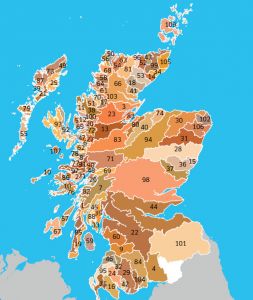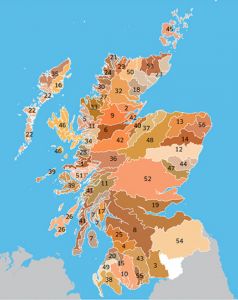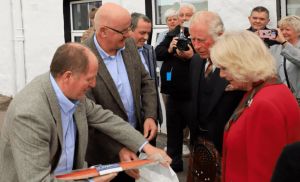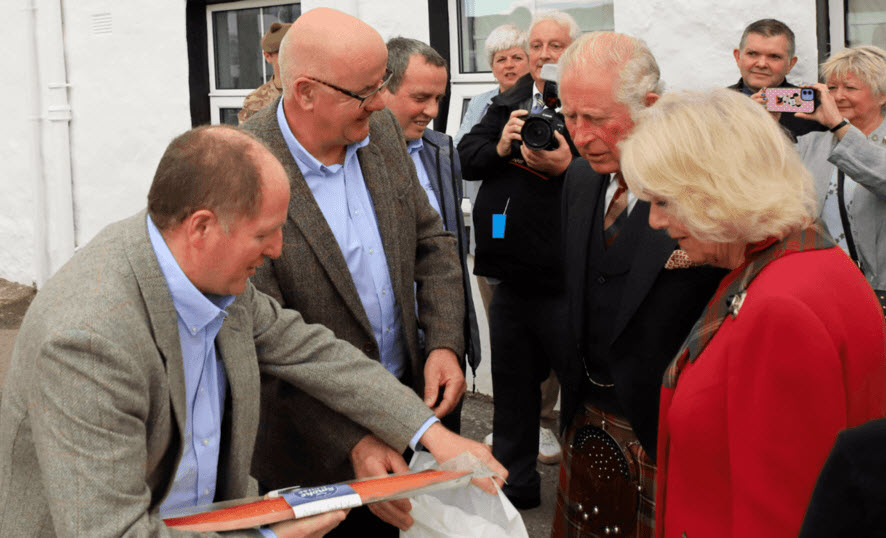It’s a win: From 1952 to 2018, the Scottish Government collected catch data for salmon and sea trout for the 109 separate fishery districts across Scotland. Whilst not perfect, this data is in many cases the only data available as to the state of wild salmonid stocks. The data is important not only because it provides a nationwide picture of salmon and sea trout stocks but also because it can be used to assess any impact salmon farming might or might not have on wild fish.
Two years ago, Marine Scotland Science changed the way thy reported these catches. They amalgamated many of the 109 fishery districts into just 56 reporting areas. In the click of a finger, they ended a time series of catch data lasting 56 years. Most critically, as most of the amalgamated districts are in the west coast, it removed the ability to measure impacts on salmon at a relatively local level. One example is that the Ewe district was merged with Little Loch Broom and the Gruinard fishery districts. Given that the salmon farm has just been removed from Loch Ewe, it is now impossible to assess whether local fish stocks are in a state of recovery or whether the salmon farm had no impact in the collapse of Loch Maree sea trout.


In terms of salmon and sea trout conservation, this change was a massive backward step yet surprisingly, all the salmon conservation organisations didn’t appear to mind. The reason for the change was that in the opinion of Marine Scotland Science, the then new GDPR regulations meant that it would be possible to determine the private information about fishery proprietors and thus by amalgamating districts, such information would be harder to establish.
I have been working with catch data since 2010 and I have absolutely no idea how knowing that six fish were caught from the River Ewe in June can be turned into financial information for local proprietors. I don’t even have any idea how many proprietors there are in the Ewe system, and I don’t see how knowing this information helps with the assessment of salmon stocks. The clear message is that Marine Scotland Science have placed more importance on the protection of business interests than the protection of salmon.
The good news is that after a long investigation by Scotland’s Information Commissioner, they have ruled that whilst with all the right bits of information, it is possible to determine the financial gain by fishery proprietors. However, it is such a complex approach and is unlikely to be used by anyone interested in just the salmon catch, that on balance, the interests of salmon conservation outweigh that of personal data and consequently Marine Scotland Science must release the missing information.
Hopefully, this means that Marine Scotland Science will return their regular catch data reporting to include the results from all 109 fishery districts. This is a victory for common sense over the commercial interests of the wild fishery sector.
It’s hot: The Herald newspaper reported that conservationists are increasing tree planting alongside Scottish rivers in a bid to create ‘living parasols’ that will protect wild salmon from climate change. The Herald says that the project comes thanks to £550,000 of extra funding aimed at supporting ongoing research into wild salmon populations. Teams are currently investigating the reason behind the large drop in numbers, with many believing climate change is driving the alarming decline in the iconic species.
I was somewhat surprised to read this news because most research effort relating to wild salmon seems to be directed at salmon farming as the cause of the declines. As I have pointed out, Marine Scotland has funded Fisheries Management Scotland for a farmed salmon interactions manager, not one dealing with climate change or in fact any other of the pressures highlighted at causing the decline of wild salmon.
The Cabinet Secretary told the newspaper that it is believed salmon mortality at sea has increased in part due to the effect of climate change on ecosystems and shifts in locations where food is abundant. Creating living parasols along Scottish rivers is hardly going to mitigate against such changes at sea.
In fact, the Herald newspaper has got the story wrong. The new funding is not to be used to create living parasols at all. Fisheries Management Scotland report on their website that the fund including £150,000 from the Crown Estate, will support sampling of juvenile and adult salmon by local Fisheries Trusts and Boards to collect scales and other biological information from fish captured throughout the country. The Crown Estate told the newspaper that this valuable research will contribute evidence that hopefully leads to a better understanding of the reasons behind the decline and inform targeted action plans to address the current issues.
Earlier this month, the Times newspaper reported that another study, funded by Marine Scotland with £150,000 will investigate why salmon returning to Scotland’s rivers are getting smaller. The project will involve the collection of scales from rod caught salmon by Fisheries Management Scotland members. As well as providing information on the age and size of rod caught salmon, the information will help form national and international management aimed at safeguarding salmon for future generations of anglers.
Could it be that the wild fisheries sector is in receipt of two lots of funding for what is effectively the same research? In fact, given that these concerns are not new, it is a puzzle that such investigations are now getting underway. After all, as the Herald points out, anglers have repeatedly warned that stocks are in crisis due to a variety of issues including barriers to migration, and of course, salmon farming. One of the issues not included in this list is commercial exploitation, especially by netting. This is because wild fish organisations successfully managed to have commercial nets closed down a few years ago. The knock-on effect of closures is that the nets used to be a valuable source of information about the state of salmon stocks, and this has been lost. So having had the nets closed down, the wild fish sector is being paid to fish for samples by rod and line instead, even though anglers pay for the privilege of fishing themselves.
The one aspect of changing climate that has not been mentioned is that the elevated temperatures now found in many Scottish rivers in the summer months is undoubtedly stressful for wild salmon, yet the fisheries sector have remained strangely silent on this issue. Some other countries have placed a ban on fishing for salmon if the temperatures rise too high. Although this is a very simple measure, there is no such plan to ban salmon fishing in Scotland above certain temperatures, although this could be part of the new, yet to be announced, wild salmon strategy.
Could it be that those recommending policy also represent the river proprietors, who run the fishing as a business – as discussed in the previous commentary. It is certainly unclear whether policies are aimed at safeguarding wild salmon or the fisheries business.
This lack of clarity also relates to another salmon fishing activity and that is taking pictures of anglers with their catch and posting on social media. Many of these pictures show anglers treating the fish inappropriately and such mishandling could lead to mortality once the fish has returned to the water. The problem for me is that in some cases, it is the local fishery board who have posted or reposted the images of the fish. The reasons for doing so are clear – see how many fish are being caught in our river and this is somewhere other anglers should come to fish too. It is simply marketing of the rivers and their beats. After all, visiting anglers don’t want to pay sums of money to fish rivers where no fish are being caught.
It’s a miracle: In his latest fishery report for Wester Ross in Trout and Salmon magazine, Andrew Graham Stewart, director of Salmon & Trout Conservation Scotland, writes that in July, one party caught 19 salmon (best 15lb) from the River Ewe and 49 finnock and sea trout up to 1lb 8oz. A week later another party caught seven grilse and one 4lb sea trout, another of 3lb, three of 2lb and five of 1lb along with 20 finnock of around 12oz. Mr Graham Stewart draws attention to the ‘considerable’ sea trout and finnock catches saying the fish have been in superb condition and remarkedly clean, carrying almost no lice. The local ghillie, Ray Dingwall, who has been on the river for eighteen years told Mr Graham Stewart that the fish have been the cleanest he has seen during all that time. In addition, local anglers have revelled about this welcome turn around.
Mr Graham Stewart points out that it cannot be a coincidence that the sea trout and finnock entering the river this summer are virtually lice free and that marine survival has improved given that the local salmon farm in Loch Ewe closed down in November 2020.
Mr Graham Stewart says that it is early days, but this is not the news that the salmon farming industry and some of its more blinkered supporters would want to hear. He couldn’t be more wrong. I have written previously that catches of sea trout and finnock would increase after the farm closed. This is not unexpected. What is interesting is that in recent years, Mr Graham Stewart has never written about actual sea trout catches from the loch in his reports, so it is impossible to know whether sea trout have been regularly landed.
For the last two years, Marine Scotland Science amalgamated the catch data from the Ewe with two other fishery districts so observers like myself have no idea if sea trout were being caught whilst the salmon farm was still operational. In S&TC’s video about Loch Maree, the local ghillie said that although there was little demand for his services, he still took anglers out in the loch, so fish must have still been caught. The reality is that since the 1990s, S&TC and others have repeated their narrative that the Loch Ewe farm had wiped out local sea trout stocks so why would any angler want to go fishing there? Catch data relies on anglers catching fish, so if there are no anglers, there are no fish being caught. It does not mean that there are no fish in the loch.
As anglers return, having been told by Mr Graham Stewart that fish are in the loch, catches will increase and Mr Graham Stewart will claim that now the farm has gone, stocks have recovered. I have previously suggested that the industry should fund a detailed independent study of what happens to Loch Maree once the farm had been removed. My understanding is that the wild fish sector wasn’t keen to be involved in this type of project, so it never happened.
Mr Graham Stewart’s comments about the industry’s more blinkered supporters is aimed directly at me. He says that I and others have taken a leaf out of the 1960s tobacco industry manual and systemically and cynically denied that salmon farming has any detrimental impact on migratory fish. I have not changed my view.
Unfortunately, Mr Graham Stewart refuses point blank any offer to meet him to discuss the issues. Instead, he has in the past reverted to the same tactics as other critics by attacking the messenger rather than focus on the message. In one fishery report in Trout and Salmon magazine he referred to me as Dr Crapper – so named apparently because of the crap I write.
Sea trout catches did not just collapse in Loch Maree; they have collapsed across Scotland. Catch data from the Aquaculture Zone shows catches declined from the 1950s, at least thirty years before salmon farming arrived on the coast. Could it be possible that whatever caused the decline from the 50s to the 80s, caused a continued decline after the 1980s too. Interestingly, I have endeavoured to find any research conducted into why sea trout declined from the 1950s onward and there was not any. It seems that anglers only became interested in the decline of sea trout after the arrival of salmon farming in Scotland.
Mr Graham Stewart ends by saying that if lice free sea trout (although earlier in his piece he referred to fish carrying almost no lice) are prevalent in 2022, then pressure will mount for numerous other farms in especially sensitive locations be closed too. However, Mr Graham Stewart seems to have forgotten his own report in which he mentioned that fish of 2, 3 and 4 lb being caught in July. These fish are not this year’s fish and must have been around whilst the farm was still operational. The fact that a few fish without lice have been caught – last year I posted a picture of a lice free sea trout caught in Gairloch – does not mean that Loch Maree has or will recover. We must wait and see. The evidence from elsewhere would suggest that there will be no long-term recovery so any action against salmon farms would be extremely premature.
Of course, what Mr Graham Stewart has continually refused to acknowledge is that Government data shows sea trout catches from the Aquaculture Zone were in decline for thirty years before salmon farming arrived in the NW Highlands. No one from the wild fish lobby has yet been able to provide an explanation as to why sea trout catches declined over this period and still do so. Perhaps whatever caused the decline from the 1950s on, is still causing the decline today and the decline has nothing to do with salmon farming at all. In the case of Loch Maree, a peer reviewed study has shown that the cause of the collapse was the removal of the 3-mile fishing limit in 1984, four years before the salmon farm began to operate. Sadly, Mr Graham Stewart is not interested in such facts because in his eyes, only salmon farming is to blame.
Finally, I would point out that not everyone connected to Salmon & Trout Conservation appears to share Mr Graham Stewart’s view. According to Fish Farming Expert, S&TC’s patron, Prince Charles recently visited the Isle of Skye and received a side of smoked salmon produced from fish grown by Organic Harvest. Prince Charles discussed the organic farming methods employed by Organic Harvest and Alex McKinnon from the company said that the Prince was very positive.


